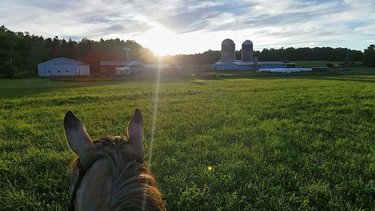County teams with agribusiness group to teach, help farmers
Enterprise file photo from Cheyenne Keppler
Sunset on a dairy: The view of Knox Valley Farm from the back of Cheyenne Keppler’s horse shows two grain silos and turquoise-colored milking parlors. Her father, Paul Keppler, sold his cows in the fall of 2018.
ALBANY COUNTY — Farmers are struggling.
The suicide rate among farmers is triple the national average. Over half of all farms in New York State operate at a loss, according to the most recent available data from the United States Department of Agriculture, from 2017.
In Albany County, that number is closer to two-thirds — 288 of 440 farms reported net losses in 2017; close to 75 percent of county farms reported selling less than $25,000 worth of agricultural products.
In its agriculture and farmland protection plan update, the county states that its “farmers are looking toward more entrepreneurial responses to market challenges … .”
To help farmers in tackling those “more entrepreneurial responses,” Albany County recently announced it had partnered with the Hudson Valley AgriBusiness Development Corporation, a not-for-profit that, according to the county, offers “specialized agribusiness support services” like loan programs, grant-writing, marketing and promotion, and comprehensive and strategic planning, as well as training and technical assistance.
Albany County’s agricultural producers — in addition to the organization’s seven other partner counties — by dint of geography are well-positioned to take full advantage of the “buy local, eat local” movement, said Todd Erling, the organization’s executive director. Erling spoke to a large group at an information session for the initiative’s rollout late last month at Cornell Cooperative Extension in New Scotland.
“Local,” Erling said, can mean a day’s drive for a commercial truck driver.
And what that really means is that there are 55 to 65 million mouths within a five-hour radius of Albany County — west to Rochester and Syracuse; north to Montreal; east to Boston; “but then you have the 800-pound gorilla,” he said, not only New York City but its greater metro area that consists of Connecticut and New Jersey; and south to Philadelphia.
The population concentration of the Northeast and mid-Atlantic, Erling said, exists nowhere else in the country. And the Hudson Valley AgriBusiness Development Corporation has expertise in accessing those markets, he said; the organization has a number of service-provider contacts in those areas.
Identifying the issues
The Hudson Valley AgriBusiness Development Corporation was established in 2007, based on a recommendation made in an American Farmland Trust study, Erling said.
The study looked at the challenges for agriculture in the Hudson Valley from an economic-development viewpoint, Erling said, rather than the more frequent viewpoint of real-estate development and the pressure that puts on communities and farms.
The study not only identified the pressures and challenges that farms were facing, Erling said, but also suggested strategies to address those challenges.
Some of the challenges the study identified, which were happening in the southern end of the Hudson Valley at the time the report was made, Erling said, are now seen in Albany County — like development pressure, whether it’s suburban housing, or large-box store and retail development, or warehouse or distribution centers.
And those types of development have been addressed by groups like Scenic Hudson or the Mohawk Hudson Land Conservancy, working with farmers to purchase development rights or conservation easements — traditional land-preservation tools.
But the American Farmland Trust study came up with four findings that were outside employing traditional land-preservation tools:
— The first finding, which led to the creation of Hudson Valley AgriBusiness Development Corporation, was that there hadn’t been a regional economic-development entity or program that included or prioritized agriculture in the food system, Erling said.
At the time, the first five years of the century, locally-based economic development programs were focused on attracting traditional businesses like warehouse distribution centers and manufacturing such as high-tech nanometer chip manufacturing in the Capital Regional;
— The second finding was that those locally-based economic development programs were not really taking into account the role farms and the food system played in economic development — as well as their potential, he said.
Some individual counties were working on incorporating agriculture into their economic-development planning but it was very ad hoc, Erling said;
— The third finding was that, since the first two findings didn’t exist, there were no economic-development programs that included agriculture. In particular, there weren’t any individual state-level programs that addressed agriculture and food systems as a priority; and
—The fourth finding was that there was no dedicated funding to implement the programs, strategy, or projects that were going to come about as part of implementing the first three findings.
Orange and Columbia counties were the Hudson Valley AgriBusiness Development Corporation’s first two partner counties, Erling said; within a year, Ulster and Dutchess counties were on board as well.
Hudson Valley works with traditional commodity farms like dairies; large-scale fruit and vegetable farms; farms that grow field crops like wheat and corn; and even with Brooklynites who’ve moved to the Hudson Valley and now make their living hocking niche flower- and plant-based elixirs.
“It’s all agriculture to us,” Erling said.
Successful programs
Hudson Valley’s Incubator Without Walls program, Erling said, was created in response to the challenges that farms and agricultural-based businesses faced daily with marketing, production, and obtaining site-plan approval.
In addition, the new Incubator Without Walls program helped identify new potential streams of capital. This includes, at the federal level, grants through the United States Department of Agriculture, at state level, grants through Regional Economic Development Councils; Empire State Development funds; and Market New York funds, a tourism grant program.
Well over two dozen state and federal grants have since been identified, according to the organization’s funding opportunities page.
In the southern end of the Hudson Valley, Erling said, his corporation helped Fishkill Farms in Dutchess County obtain a USDA-funded grant, which led to a planning grant, which led to an Empire State Development implementation grant.
The three grants helped Fishkill Farms to move its hard-cider production onto its property, whereas previously the farm had been paying to produce the cider offsite. This allowed the farm to acquire more land to plant cider-specific trees, place cider-production equipment onsite, and develop and implement a marketing plan as production increased.
Hudson Valley last year helped Berle Dairy Farm in Rensselaer County to successfully apply for a USDA grant, Erling said, for which the farm received about $10,000 in assistance for equipment that is more energy efficient.
Finding capital
The Hudson Valley AgriBusiness Development Corporation is also working on the fourth finding in the American Farmland Trust report: Finding dedicated capital.
Hudson Valley has worked with the state to open up traditional economic-development loan programs — which have very competitive interest rates — for equipment and capital improvements for farms and businesses in the food system.
Hudson Valley AgriBusiness Development Corporation is one of about six intermediary lenders in the state, Erling said. The organization borrows money from the state at a very low interest rate — it then makes equipment and capital-improvement loans at a slightly marked-up interest rate, to cover staff time for administering the program.
Hudson Valley also has a Food Security and Food Rescue Program that matches farmers or food businesses — like restaurants or caterers — that have surplus but safe consumable food with a local pantry serving hungry within a community.
The program is outside of the traditional food-bank system, Erling said, since connections are made through a phone app. For example, a farmer may have half-a-dozen crates of apples that, for whatever reason, he is going to donate. The farmer can go on the app, let it be known that he has apples to donate while on the other end, a volunteer is willing and able to pick up those apples and deliver them where they need to go.
There is also the Farm and Food Funding Accelerator program, which is more curriculum-based, he said, where businesses that are ready to expand or are looking to move into a new market will sign up for a six-month intensive program, which includes homework and twice-a-month meetings.
The program is supposed to prepare its students to apply for their own grant funding as well as teach them how to apply for direct commercial lending, whether through Farm Credit or local banks.



